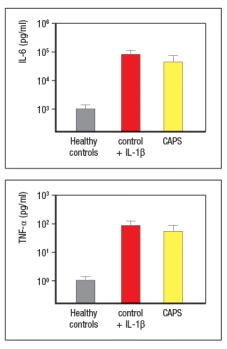Essay
Autoimmune diseases are characterized by an adaptive immune response directed at self-tissue or self-antigens. One hallmark of these diseases is their responsiveness to treatments that inhibit B or T lymphocytes. A set of diseases known as autoinflammatory diseases are, instead, caused by aberrant activation of innate immune responses. Some of these are monogenic inherited disorders, for example, a spectrum of diseases resulting from mutations in the innate sensor protein, NLRP3. These diseases are inherited as autosomal dominant diseases, and are due to gain-of-function mutations in NLRP3, a key component of the inflammasome. Altogether, these disorders are known as CAPS, for cryopyrin-associated periodic syndrome, as they generally cause periodic episodes of fever and inflammation. Common symptoms of these disorders include severe skin rashes, fevers, joint disease, and central nervous system disease. A biologic has been developed to treat patients with CAPS, with remarkable success. Initial studies first examined the responses of peripheral blood cells from CAPS patients to this biologic, compared to controls. For these experiments, peripheral blood mononuclear cells (all white blood cells) were cultured for 48 hours, without stimulation, and the cytokine levels in the supernatants were then measured by ELISA. These data are shown in Figure. 
a) Based on these data, which cells in the peripheral blood of CAPS patients are spontaneously producing cytokines?
b) Based on the fact that CAPS patients have a mutation in a single gene, NLRP3, propose an explanation for the cytokine data shown above
Next, peripheral blood mononuclear cells from controls or CAPS patients were stimulated in vitro with LPS alone, and protein was isolated from cell lysates and cell supernatants, and immunoblotted as shown in Figure 
c) What do these results indicate about the consequences of the gain-of-function NLRP3 mutations in patients with CAPS?on normal healthy peripheral blood mononuclear cells, cells from healthy controls were cultured in vitro for 48 hours in the presence or absence of IL-1 . Cytokines in the supernatants were then analyzed, in comparison to supernatants from cultured CAPS patients' cells. For these studies, the CAPS patients' cells were cultured without stimulation and in the absence of any biologic treatment. These data are shown in Figure. 
In addition, serum cytokine levels from CAPS patients were measured before and after treatment with the biologic, and the results are shown in Table .
d) What do these data suggest a possible explanation for the inflammatory syndrome seen in CAPS patients?
e) Based on all of these data, what is the likely target of the biologic used to treat the CAPS patients?
Correct Answer:

Verified
a) Monocytes. This pattern of cytokine p...View Answer
Unlock this answer now
Get Access to more Verified Answers free of charge
Correct Answer:
Verified
View Answer
Unlock this answer now
Get Access to more Verified Answers free of charge
Q19: Cyclosporin A and rapamycin are each used
Q20: One clinical trial performed in the early
Q21: In the first few days following organ
Q22: Early efforts to develop a
Q23: Conjugate vaccines, such as those developed against
Q25: The vitamin D3 metabolite 1,25(OH)<sub>2</sub>D<sub>3</sub> binds
Q26: Safety concerns in the latter part of
Q27: As of 2014, a total of 452
Q28: A recent strategy showing some promise for
Q29: The US Department of Health and Human